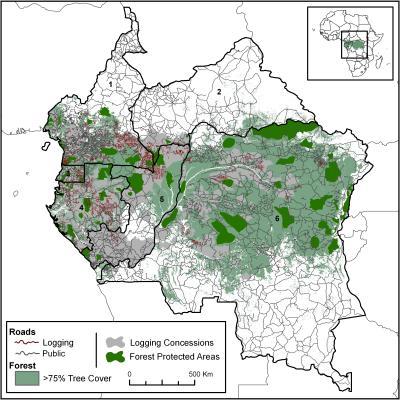Sediment cores retrieved from the Arctic’s deep-sea floor by the Integrated Ocean Drilling Program’s Arctic Coring Expedition (ACEX) report that the Arctic Ocean changed from a landlocked body of water (a ‘lake stage’) through a poorly oxygenated ‘estuarine sea’ phase to a fully oxygenated ocean at 17.5 million years ago during the latter part of the early Miocene era.
Earth
The transition from an ice age to an ice-free planet 300 million years ago was highly unstable, marked by dips and rises in carbon dioxide, extreme swings in climate and drastic effects on tropical vegetation.
"This is the best documented record we have of what happens to the climate system during long-term global warming following an ice age," said Isabel Montañez, professor of geology at the University of California, Davis, and lead author on the paper. But she added that these findings cannot be applied directly to current global warming trends.
Using an ocean of data, sophisticated mathematical models and supercomputing resources, researchers at the Department of Energy’s Oak Ridge National Laboratory are putting climate models to the test with particular focus on weather extremes.
Climate models are reliable tools that help researchers better understand the observed record of ocean warming and variability.
That's the finding of a group of Livermore scientists, who in collaboration with colleagues at Scripps Institution of Oceanography, had earlier established that climate models can replicate the ocean warming observed during the latter half of the 20th century, and that most of this recent warming is caused by human activities.
Humans have yet to see Earth's center, as did the characters in Jules Verne's science fiction classic, "Journey to the Center of the Earth." But a new NASA study proposes a novel technique to pinpoint more precisely the location of Earth's center of mass and how it moves through space.
A tiny single-celled organism that plays a key role in the carbon cycle of cold-water oceans may be a lot smarter than scientists had suspected.
Mixotrophs are species of algae that act as "plants" when they produce their own food and as “animals” when they eat other plants.
Wanderson Carvalho from the University of Kalmar is studying these algae to understand their potential impact on the environment, the economy and public health issues.
An all-electric aircraft will be more efficient, produce fewer greenhouse emissions and be quieter but current technology cannot be used because an electric motor using conventional magnets can weigh up to five times as much as conventional jet engine and not be as fuel efficient.
Alan Hubert and Dixie Dansercoer collect snow-depth data for ESA's CryoSat-2 mission. They're seasoned polar explorers so they are used to dealing with physically demanding and downright harsh conditions but what they encountered during their three and a half-month expedition from Russia to Greenland via the North Pole was dangerous even for them.
Human-caused nitrogen deposition has been indirectly “fertilizing” forests, increasing their growth and sequestering major amounts of carbon, a new study suggests.
The findings create a more complex view of the carbon cycle in forests, where it was already known that logging or other stand-replacement events – whether natural or not – create periods of 5-20 years when there is a net release of carbon dioxide from forests to the atmosphere, instead of sequestration as they do later on.
Some call it the eighth wonder of world. Others say it's the next Great Wall of China.
Upon completion in 2009, the Three Gorges Dam along China’s Yangtze River will be the world's largest hydroelectric power generator and one of the few man-made structures so enormous that it's actually visible to the naked eye from space.
While solar power and hybrid cars have become popular symbols of green technology, Stanford researchers are exploring another path for cutting emissions of carbon dioxide, the leading greenhouse gas that causes global warming.
Carbon capture and storage, also called carbon sequestration, traps carbon dioxide after it is produced and injects it underground. The gas never enters the atmosphere. The practice could transform heavy carbon spewers, such as coal power plants, into relatively clean machines with regard to global warming.
The Biscuit Fire of 2002 burned more severely in areas that had been salvage logged and replanted, compared to similar areas that were also burned in a 1987 fire but had been left to regenerate naturally, a new Oregon State University Study concludes.
The analysis, one of the first to ever quantify the effect of salvage logging and replanting on future fire severity, is being published this week in Proceedings of the National Academy of Sciences, a professional journal.
Monitoring the saltiness of the ocean water could provide an early indicator of climate change. Significant increases or decreases in salt in key areas could forewarn of climate change in 10 to 20 years time. Presenting their findings at a recent European Science Foundation (ESF) conference, scientists predicted that the waters of the southern hemisphere oceans around South Africa and New Zealand are the places to watch.
Though the dense humid forests of Central Africa have been regarded as among the most pristine on Earth, the expansion of industrial logging and the accompanying proliferation of road density are threatening the future of this important ecosystem. Logging concessions and road distribution in Central Africa: Cameroon (1), Central African Republic (2), Equatorial Guinea (3), Gabon (4), Republic of Congo (5), Democratic Republic of Congo (6). Credit: Woods Hole Research Center (whrc.org)
Logging concessions and road distribution in Central Africa: Cameroon (1), Central African Republic (2), Equatorial Guinea (3), Gabon (4), Republic of Congo (5), Democratic Republic of Congo (6). Credit: Woods Hole Research Center (whrc.org)